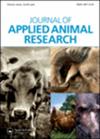斯洛伐克奶牛场结节二氏杆菌和坏死梭杆菌的患病率
IF 1.9
4区 农林科学
Q3 AGRICULTURE, DAIRY & ANIMAL SCIENCE
引用次数: 0
摘要
本文章由计算机程序翻译,如有差异,请以英文原文为准。
Prevalence of Dichelobacter nodosus and Fusobacterium necrophorum on dairy farms in Slovakia
ABSTRACT The aim of this study was to determine the prevalence of bacteria Dichelobacter nodosus (D. nodosus) and Fusobacterium necrophorum (F. necrophorum) in non-lame dairy cows on eight Slovak dairy herds. In total, 1,631 Holstein Friesian dairy cows were included in the study. Information of the cows was collected from on-farm software included cow ID, lactation number (heifer/cow), year milk yield (kg), and DIM on collection date. The PCR method detected D. nodosus and F. necrophorum on the feet of 1,394 (85.5%) and 373 (22.1%) dairy cows, respectively (p < 0.05). No dairy farm could be found without positive samples for D. nodosus and the majority of the farms were free or had very low prevalence of F. necrophorum (0–9.1%). Statistical difference for the prevalence of D. nodosus and F. necrophorum in different Slovak regions was detected for both strains. Logistic regression revealed an association between both D. nodosus and F. necrophorum identification and annual milk production (odds ratios = 0.69 and 0.32, respectively). Our data demonstrates that D. nodosus is present on the feet of almost every dairy cow what means a potential risk for cattle to develop foot rot. Furthermore, both bacteria are associated with decreased annual milk production.
求助全文
通过发布文献求助,成功后即可免费获取论文全文。
去求助
来源期刊

Journal of Applied Animal Research
农林科学-奶制品与动物科学
CiteScore
2.70
自引率
0.00%
发文量
80
审稿时长
6 months
期刊介绍:
Journal of Applied Animal Research (JAAR) is an international open access journal. JAAR publishes articles related to animal production and fundamental aspects of genetics, nutrition, physiology, reproduction, immunology, pathology and animal products. Papers on cows and dairy cattle, small ruminants, horses, pigs and companion animals are very welcome, as well as research involving other farm animals, aquatic and wildlife species. In addition, manuscripts involving research in other species that is directly related to animal production will be considered for publication.
 求助内容:
求助内容: 应助结果提醒方式:
应助结果提醒方式:


